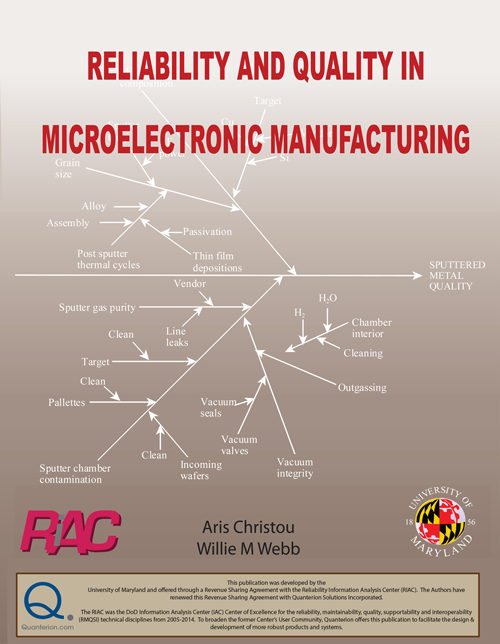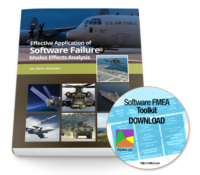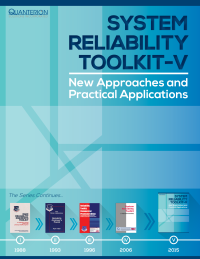| 1 Microelectronics Industry and Manufacturing Trends in Reliability |
1 |
| 1.1 Introduction |
1 |
| 1.2 Built-In Reliability Approach |
4 |
| 1.3 Manufacturing Yield and Reliability |
7 |
| 1.4 Reliability, Yield and Quality Applied to Microelectronics |
9 |
| 1.5 Summary |
11 |
| 1.6 References |
13 |
| 2 Multiple use Microelectronics: A Reliability Approach |
15 |
| 2.2 Approaches and Misconceptions |
17 |
| 2.2.1 Product Demonstrators |
18 |
| 2.2.2 Manufacturing Technologies and Innovation |
18 |
| 2.2.3 Communications System Life Cycle Costing and R/D Selection |
20 |
| 2.2.4 Present Specifications And Practices |
20 |
| 2.3 Integration of Defense and Commercial Products: The Proposed Solution |
24 |
| 2.3.1 Microelectronics |
24 |
| 2.3.2 Availability of Commercial Components |
25 |
| 2.4 Electronic Assemblies |
30 |
| 2.5 Priorities for The 2000s In Electronics |
32 |
| 2.5.1 Peripheral Technologies |
37 |
| 2.5.2 Commercial Specifications and Processes |
37 |
| 2.6 Where Is The Competition? |
38 |
| 2.7 Current Hopes and Summary |
39 |
| 2.8 References |
41 |
| 3 Manufacturing Yield and Reliability |
43 |
| 3.1 Manufacturing Yield and Reliability |
43 |
| 3.1.1 Mechanisms of Yield Loss |
43 |
| 3.1.2 Uniform Density of Point Defects |
44 |
| 3.1.3 Simple Non-Uniform Distributions of Defects (D0) |
45 |
| 3.2 Failure Distributions/Reliability Functions in Microelectronics |
49 |
| 3.2.1 Cumulative Distribution Function (cdf) |
50 |
| 3.3 Reliability Indicators In Microelectronics |
60 |
| 3.3.1 Emission Microscopy for Reliability Indication |
61 |
| 3.3.2 IDDQ as A Reliability Indicator |
62 |
| 3.3.3 Other Reliability Indicators |
65 |
| 3.3.4 Algorithm To Incorporate Noise Tests in Microcircuit Fabrication |
67 |
| 3.3.5 Summary |
68 |
| 3.4 References |
69 |
| 4 Manufacturing of Microcircuits for Reliability |
71 |
| 4.1 Introduction |
71 |
| 4.2 Microelectronic Circuit Elements |
73 |
| 4.3 VLSI Device Fundamentals |
76 |
| 4.3.1 Materials |
76 |
| 4.3.2 Device Classification |
77 |
| 4.3.3 VLSI Device Parameters |
81 |
| 4.3.4 Device Models and Parameters |
81 |
| 4.4 Data-Base Management System for IC Manufacture |
82 |
| 4.4.1 Computer Integrated Manufacturing |
84 |
| 4.4.2 Data-Base Management System and Data Correlation |
85 |
| 4.4.3 Correlation Analysis |
85 |
| 4.5 References |
89 |
| 5 Crystal Growth and Substrate Mechanisms |
91 |
| 5.1 Silicon Starting Material |
91 |
| 5.2 Crystal Growth Theory |
91 |
| 5.3 Crystal Characteristics and Evaluationy |
94 |
| 5.3.1 Processing Preparation |
97 |
| 5.3.2 Yield Strength of Silicon |
98 |
| 5.4 Epitaxial Growth on Semiconductor Substrates |
98 |
| 5.4.1 VPE of Silicon |
99 |
| 5.4.2 Advanced CVD Methods: MBE |
102 |
| 5.5 Substrate Mechanical Failures and Reliability |
104 |
| 5.5.1 Thermal-Mechanical Stresses in Semiconductor Substrates |
106 |
| 5.6 Failure Mechanisms and Damage Models of The Semiconductor Substrate |
115 |
| 5.6.1 Brittle Fracture |
115 |
| 5.6.2 Fatigue Crack Initiation and Propagation |
121 |
| 5.6.3 Mechanical Properties of GaAs Wafers |
123 |
| 5.6.4 Modulus of Elasticity |
124 |
| 5.6.5 Modulus of Rupture |
127 |
| 5.6.6 Coefficient of Thermal Expansion and Summary |
132 |
| 5.7 Approach for Mechanical Reliability Design |
134 |
| 5.7.1 Design Variables and Constraints |
136 |
| 5.8 References |
137 |
| 6 Oxidation and Dielectrics in Microcircuit Processing |
141 |
| 6.1 Introduction to Oxidation |
141 |
| 6.2 Redistribution of Impurities During Oxidation |
145 |
| 6.3 The Thermal Oxidation Process |
147 |
| 6.4 Chemically Vapor Deposited (CVD) Films |
148 |
| 6.4.1 Sputtered Dielectric Films |
149 |
| 6.4.2 Silicon Nitride |
149 |
| 6.5 Charge Stability and Reliability Implications |
149 |
| 6.5.1 Radiation Induced Trapped Charge |
152 |
| 6.5.2 Negative Bias Instability |
152 |
| 6.5.3 Hot Carrier Trapping in SiO2 |
153 |
| 6.6 Summary |
154 |
| 6.7 References |
155 |
| 7 Reliable Active Layer Doping by Diffusion and Ion Implantation |
157 |
| 7.1 Introduction to Active Layer Formation |
157 |
| 7.1.1 Diffusion |
157 |
| 7.1.2 Diffusion of Zn → GaAs From SiO2 |
161 |
| 7.2 Layout Design Guidelines |
167 |
| 7.3 Ion Implantation for Active Layer Doping |
168 |
| 7.3.1 Cross-Sections and Stopping Powers |
170 |
| 7.3.2 Ion Channeling |
172 |
| 7.3.3 Material Damage by Ion Implantation |
173 |
| 7.4 Summary |
174 |
| 8 Pattern Transfer in Microcircuit Manufacturing |
175 |
| 8.1 VLSI Lithography |
175 |
| 8.1.1 Photoresist Composition |
176 |
| 8.1.2 Manufacturing Technology |
176 |
| 8.1.3 Basics of Lithography |
178 |
| 8.2 Optical Lithography |
185 |
| 8.2.1 Modified Illumination Technology |
185 |
| 8.2.2 Resolution Limit |
187 |
| 8.2.3 Practical Resolution |
187 |
| 8.2.4 Advanced Image Formation Techniques |
188 |
| 8.3 Electron Beam Lithography |
189 |
| 8.3.1 Technology Trends |
190 |
| 8.3.2 Mask Manufacturing |
191 |
| 8.4 X-Ray Lithography |
191 |
| 8.4.1 Various Forms of X-Ray Lithography |
192 |
| 8.4.2 Limits of X-Ray Lithography |
192 |
| 8.5 Key Lithography Equations |
194 |
| 8.5.2 Projection Printing |
195 |
| 8.5.3 Electron Beam Lithography |
196 |
| 8.5.4 Electron Optics |
197 |
| 8.5.5 X-Ray Lithography Sources |
198 |
| 8.6 Summary |
200 |
| 8.7 References |
201 |
| 9 Metallizations for Devices and Circuits |
203 |
| 9.1 Failure Mechanisms of VLSI And GaAs IC Metallizations |
203 |
| 9.1.1 Corrosion of Al Interconnects |
203 |
| 9.1.2 Metallization Reliability Issues |
204 |
| 9.1.3 Gold Bonding and IC Failures |
204 |
| 9.2 The Gold Bond Failure Mechanism |
205 |
| 9.2.1 Failure Mechanism Related to Contamination |
206 |
| 9.2.2 The Failure Modes |
213 |
| 9.3 Electromigration In Microcircuit Metallizations |
215 |
| 9.3.1 Electromigration Under Circuit Conditions |
216 |
| 9.3.2 Empirical Electromigration Results |
222 |
| 9.3.3 Reducing Electromigration Data |
226 |
| 9.3.4 Design and Manufacturing Guidelines |
229 |
| 9.4 References |
231 |
| 10 Device Packaging and Microcircuit Characterization |
235 |
| 10.1 Packaging and Reliability |
235 |
| 10.1.1 Market Trend Towards Surface Mount Packages |
235 |
| 10.1.2 Computer Modeling of Stress in Silicon and Molding Compound |
237 |
| 10.1.3 Test Structures for Package and Product Reliability |
238 |
| 10.2 Chip Preparation for Plastic Package Reliability |
241 |
| 10.2.1 Flip-Chip Technology and Thermal Fatigue |
241 |
| 10.2.2 Molding Compounds and Thermal Characterization of Packages |
241 |
| 10.2.3 Surface Mount Technology |
243 |
| 10.2.4 High Pin Count and Tape Automated Bonding |
245 |
| 10.3 Introduction to Characterization of Manufacturing and Reliability |
246 |
| 10.3.1 Analytical Techniques |
246 |
| 10.3.2 Compound Analysis Techniques |
255 |
| 10.4 Selection of Characterization Method |
259 |
| 10.4.1 Nature and Range of Data Yield |
259 |
| 10.4.2 Beam Induced Damage |
259 |
| 10.4.3 Detection Limits |
259 |
| 10.4.4 Sampling Depth and Spatial Resolution |
259 |
| 10.5 References |
261 |
| 11 Manufacturing of Plastic Integrated Circuits |
263 |
| 11.1 Introduction |
263 |
| 11.2 Primary Package Concerns |
263 |
| 11.2.1 Device Susceptibility |
264 |
| 11.2.2 Package Design |
265 |
| 11.2.3 Material Control |
265 |
| 11.2.4 Process Control |
265 |
| 11.3 Materials for Molded Plastic Packages |
265 |
| 11.3.1 Molding Compounds |
265 |
| 11.3.2 Die Attach Adhesives |
270 |
| 11.3.3 Leadframe Materials |
271 |
| 11.4 Manufacturing Process and Process Flow |
272 |
| 11.4.1 Transfer Molding Process |
274 |
| 11.4.2 Injection Molding Process |
281 |
| 11.4.3 Reaction Injection Molding Process |
282 |
| 11.5 Manufacturing Defects |
282 |
| 11.5.1 Package Cracking |
282 |
| 11.5.2 Paddle Shift |
283 |
| 11.5.3 Wire Sweep |
283 |
| 11.5.4 Defect Location |
283 |
| 11.5.5 Passivation Layer Cracking |
284 |
| 11.5.6 Delamination of Interfaces |
284 |
| 11.5.7 Metallization Deformation |
284 |
| 11.5.8 Ball-Bond Liftoff, Shearing, and Fracture |
286 |
| 11.6 Package Mounting |
288 |
| 11.6.1 Through-Hole Mounting |
288 |
| 11.6.2 Surface Mount Technology |
289 |
| 11.7 Non-Destructive Failure Analysis of Plastic Packages |
294 |
| 11.7.1 Scanning Acoustic Microscope |
294 |
| 11.7.2 Scanning Laser Acoustic Microscope |
294 |
| 12 Manufacturing of Microelectro Mechanical Systems and Computer Aided Control of Micromachining |
299 |
| 12.1 Introduction to Microelectromechanical Systems |
299 |
| 12.2 MEMS Devices |
300 |
| 12.1.1 Sensors |
300 |
| 12.2.2 Microactuators |
304 |
| 12.3 MEMS Fabrication Technology |
307 |
| 12.3.1 Bulk Micromachining |
307 |
| 12.3.2 Surface Micromachining |
308 |
| 12.3.3 Liga Process |
311 |
| 12.4 Computer Aided Design of Micromachining |
312 |
| 12.4.1 CAD tools |
312 |
| 12.4.2 CAD architecture |
313 |
| 13 Reliable Manufacturing of Electronic Packages |
319 |
| 13.1 Introduction |
319 |
| 13.2 Surface-Mount Technology by Robots |
319 |
| 13.4 Assembly System Configurations |
323 |
| 13.4.1 Single workstation assembly systems |
323 |
| 13.4.2 Series assembly systems |
323 |
| 13.4.3 Parallel assembly systems |
324 |
| 13.4.4 Other assembly system configurations |
324 |
| 13.5 Industrial Robot Configurations |
325 |
| 13.5.1 Articulated or revolute configuration |
328 |
| 13.5.2 SCARA configuration |
329 |
| 13.5.3 Working coordinate system for robotic assembling |
330 |
| 13.6 End Effectors |
331 |
| 13.6.1 Description of end effectors |
331 |
| 13.6.2 End effector path generation |
334 |
| 13.7 Analysis of The Assembly Processes |
335 |
| 13.7.1 Description of robotic tools for electronic assemblies |
336 |
| 13.8 Summary |
337 |
| 13.9 References |
339 |
| 14 Manufacturing of Electronic Microwave Substrates for Packaging of Monolithic Microwave Circuits |
341 |
| 14.1 Introduction |
341 |
| 14.2 Manufacturing Processes for LTCC |
342 |
| 14.2.1 Material preparation |
344 |
| 14.2.3 Layer personalization |
348 |
| 14.2.4 Substrate fabrication |
350 |
| 14.3 Electrical Properties |
352 |
| 14.3.1 Dielectric constant |
353 |
| 14.3.3 Crosstalk coupling noise |
355 |
| 14.3.4 Loss tangent |
356 |
| 14.3.6 Skin effect |
369 |
| 14.4 Mechanical Properties |
370 |
| 14.5 Physical Properties |
370 |
| 14.5.1 Surface characteristics |
370 |
| 14.5.2 Surface Impurities |
372 |
| 14.5.3 Bulk quantitative and qualitative analysis |
372 |
| 14.6 Failure Mechanisms and Models |
372 |
| 14.6.1 Substrate fracture |
373 |
| 14.6.2 Fatigue crack propagation in the substrate |
373 |
| 14.7 Tests to Detect Adhesion Failures Between Layers of LTCC Sheets |
373 |
| 14.7.1 X-Ray photo-electron spectroscopy (XPS or ESCA) analysis |
374 |
| 14.7.2 Microhardness analysis |
374 |
| 14.8 Applications |
374 |
| 14.8.1 Application of LTCC substrates for microwave frequencies |
374 |
| 14.8.2 Other Applications of LTCC substrates |
374 |
| Index |
374 |








